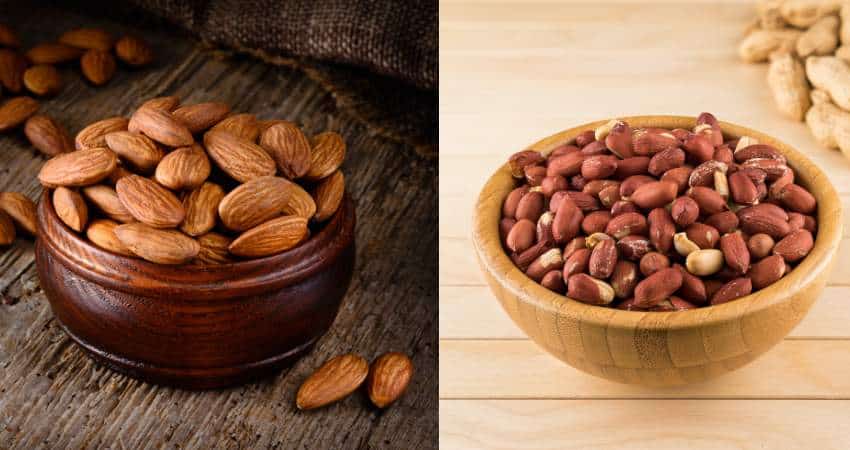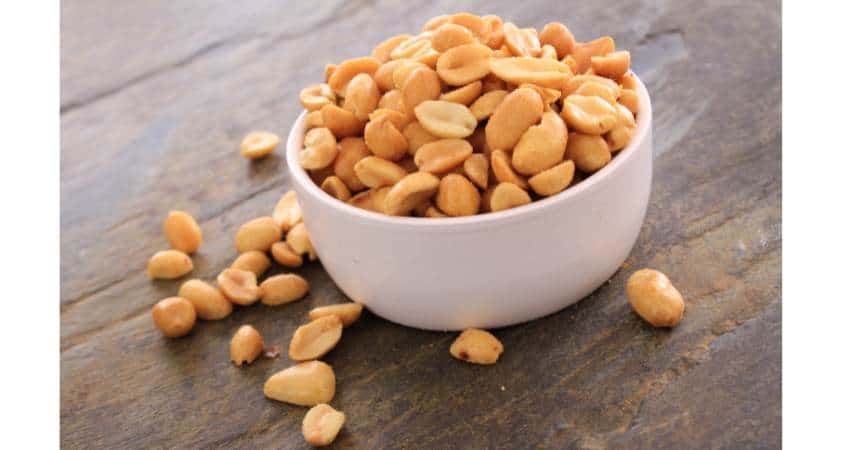Peanuts vs Almonds: Which is Healthier? Let’s Compare
As a Certified Health Coach informing clients about nuts is part of my job. Since peanuts and almonds provide many nutrients many of my clients wonder if one is better. Therefore, let’s answer, which one is better for you?
Almonds are better than peanuts due to their greater percentage of minerals, vitamin E and phytonutrients. They have less calories, more fiber and a better glycemic score than peanuts making them better for weight loss, diabetics and sustained energy throughout the day.
This article will include a side-by-side comparison of their nutrients. In addition, we’ll compare their health benefits, costs, glycemic and satiety scores.
I’ve researched both for my health coaching job and personal use. I’ve purchased, researched and consumed both prior to, during and after writing this article. They are part of my own nutritional plan.
Peanuts vs Almonds: Nutritional Analysis
To determine which one is healthier, we need to look at each nut’s nutritional composition. The below table compares the macronutrient, vitamin, and mineral content of both:
| Nutrient | Almonds (per 100g) | Peanuts (per 100g) |
| Calories | 579 | 587 |
| Fiber | 12.5 g | 8.4 g |
| Saturated Fat | 3.8 g | 7.7 g |
| Trans Fat | 0.02 g | 0.03 g |
| Monounsaturated Fat | 31.15 mg | 25.8 mg |
| Polyunsaturated Fat | 12.25 mg | 9.8 mg |
| Sugar | 4.4 g | 4.9 g |
| Carbohydrates | 21.6 g | 21.3 g |
| Sodium | 5.95 mg | 18 mg |
| Omega 3 Fatty Acids | 0.003 g | 0.026 g |
| Omega 6 Fatty Acids | 12.326 g | 0.719 g |
| Protein | 21.2 g | 24.4 g |
| Vitamin A | 2 IU | 0 IU |
| Vitamin B1 (Thiamin) | 0.205 mg | 0.152 mg |
| Vitamin B2 (Riboflavin) | 1.138 mg | 0.197 mg |
| Vitamin B3 (Niacin) | 3.618 mg | 14.355 mg |
| Vitamin B5 (Pantothenic Acid) | 0.471 mg | 1.011 mg |
| Vitamin B6 | 0.137 mg | 0.466 mg |
| Vitamin B9 (Folate) | 44 mcg | 97 mcg |
| Vitamin E | 25.6 mg | 4.9 mg |
| Calcium | 269 mg | 58 mg |
| Magnesium | 269.5 mg | 175 mg |
| Iron | 3.7 mg | 1.6 mg |
| Phosphorous | 476 mg | 360.5 mg |
| Copper | 1.015 mg | 0.42 mg |
| Potassium | 733 mg | 634 mg |
| Zinc | 3.08 mg | 2.765 mg |
| Phytonutrients | 7 phytonutrients (vanillic acid, protocatechuic acid,
catechin, flavonoids, methyl quercetin, p-hydroxybenzoic acid, and kaempferol) |
5 phytonutrients (phytic acid, p-coumaric acid, isoflavones,
phytosterols, and resveratrol) |
| GI (Glycemic Index) | 0 | 23 |
After checking the nutrients above it’s difficult to determine which is healthier. They each provide different amounts of vitamins and minerals, although the same nutrients. Therefore, let’s take a closer look.
Almonds are healthier than peanuts due to its higher percentage of minerals, fiber and phytonutrients. They provide more zinc, potassium, copper, phosphorus, iron, magnesium, calcium, vitamin E, vitamin A, thiamin, riboflavin and fatty acids. Almonds have a better glycemic index.
Peanuts contain more protein and B vitamins than almonds. They provide a higher percentage of protein, niacin, B5, B6 and folate.
Other than vitamin A and phytonutrients, they both contain the same vitamins and minerals just in different percentages. There isn’t a huge difference between the two nuts when it comes to macronutrients.
I consume both almost everyday as a snack. I add peanuts into the mixed nuts I buy at the supermarket. This way I receive both of their benefits and the varied taste helps avoid boredom.

Peanut vs Almond: Which to Choose
It’s difficult to argue against either one of these nuts. Both are considered healthy and a terrific source of nutrients. Some people will alternate between the two to break the boredom. Others combine the two into a mixed nut option.
The mixed nut option is my favorite. I purchase a big jar of mixed nuts containing almonds, cashews, pistachios and pecans. I then purchase the more affordable dry roasted peanuts and add it to the mixed nuts.
Adding the less priced peanut provides more variety and increases the volume of the mixed nuts making them a little more affordable.
Some people have different goals and may want to pick one based on those goals. Let’s take a look at some.
Weight Loss and Calories
One popular goal is weight loss. If you want to shed some fat from the midsection, you may ask, peanuts vs almonds, which is better for weight loss?
Almonds are better for weight loss than peanuts due to its fewer calories, more fiber and lower glycemic index. Almonds have a glycemic index of zero and peanuts 23. This combined with more fiber makes them take longer to digest, causes less sugar spikes and makes you feel full longer.
Of course, they should be consumed in moderation, and as part of a well-balanced eating plan to gain the maximum weight loss benefits. The calories in any nut add up pretty fast by eating too many.
Bodybuilding
If you’re in the gym lifting weights your goal may be to gain lean muscle mass. Let’s take a closer look at which is better for bodybuilding.
Peanuts are better for building lean muscle mass than almonds due to its higher percentage of protein. The carbohydrates and calories between the two nuts are almost equal. The slightly higher protein percentage helps to build and repair muscle.
On the days I go to the gym, I often snack on mixed nuts as a snack on the way home.
Bodybuilders spend a lot of money on supplements. Choosing peanuts is the more affordable option.

Low-carb Diet
If your goal is to consume a low-carb diet then carbohydrates are your number one concern. If you’re on a low-carb diet, you’ll want to know, almonds vs peanuts, which has more carbohydrates
Peanuts and almonds provide almost an equal number of carbohydrates. Peanuts contain 6.04 grams of carbohydrates per 1 ounce serving. Almonds contain 6.12 grams of carbohydrates per 1 ounce serving. If you’re on a Keto or low-carb diet, the difference between the two nuts is minimal.
Another consideration for low-carb diets is the amount of fat. Both of them provide 14.1 grams of fat per 1 ounce serving.
Gluten Free
Peanuts and almonds are naturally gluten free. In addition, both nuts can be made into a nut flour and used as a substitute for regular flour in gluten free recipes.
My Vitamix blender I use at home can make any nut flour in seconds. Check out my blender review here, Vitamix Venturist V1220 Review.
The video below explains how to make almond flour.
Glycemic Index
The glycemic index of food is important especially if blood sugar levels are a concern. Avoiding blood sugar spikes is an important part of consuming healthy food. This is true for diabetics or anyone worrying about their health.
The Glycemic Index (GI) is a scale measuring how fast a particular food raises the blood sugar in the blood4. Blood sugar spikes can lead to health complications with the heart, nerves, kidneys and eyes5.
Foods on the GI scale are categorized as:
- Low-GI foods: 55 or under
- Medium-GI foods: 56-69
- High-GI foods: 70 or over
How blood sugars levels are affected:
- Foods with a glycemic index 70 or more cause a quicker spike in blood sugar levels.
- Foods with a glycemic index 56 to 69 cause a moderate spike in blood sugar levels.
- Foods with a glycemic index 55 or less cause a slow spike in blood sugar levels.
Having more knowledge of the glycemic index of food and how it raises blood sugar, many people wonder which one has a higher glycemic index?
Peanuts and almonds are considered low glycemic foods although almonds are lower. Almonds fall into the low glycemic index with a GI of zero. Peanuts have a GI of 23.
Satiety Index
Satiety is a term used to explain the feeling of being full and the loss of appetite which occurs after eating food. The satiety index is a scale showing how full a person feels after eating a certain food.
The satiety index was developed in 1995 from a study which tested 38 foods. The foods were ranked how they satisfied a person’s hunger. Foods scoring under 100 are considered less filling and foods scoring above 100 are considered more filling ((National Center for Biotechnology Information: A satiety index of common foods)).
The table below shows the satiety scores of snacks noted in the study.
| Snack | Satiety Index Score |
| Mars candy bar | 70% |
| Peanuts | 84% |
| Crisps | 91% |
| Ice Cream | 96% |
| Jellybeans | 118% |
| Popcorn | 154% |
Peanuts finished 5th out of the six snack foods listed in the table above. Unfortunately, almonds were not included in the 1995 study. Even though other studies have determined they are good snacks for satiety.
In one study 42 people were given either almonds or crackers as a mid-morning snack two hours after eating breakfast. The serving sizes were equal between the two foods. The researchers found the people exhibited lower hunger and the desire to eat after eating the almonds6.
In another study 15 people were given peanuts to snack on daily for a period of eight weeks. Even though they weren’t compared to another snack food, the researchers determined they had a high satiety value overall ((National Center for Biotechnology Information: Snack Food, Satiety, and Weight)).
High satiety food is likely to have a high satiety score for the following reasons:
- High in protein.
- High in fiber.
- High in volume (foods containing a lot of water or air).
- Low in energy density (foods low in calories for their weight).
Find out how pistachios compared in my article and find out if they are better.
Health Benefits of Almonds
The video below explains the health benefits of almonds.
Diabetes
Many type 2 diabetics are deficient in magnesium, a vital mineral for regulating blood sugar levels. Almonds contain more magnesium and have a lower glycemic index, which also helps sustain blood sugar levels.
Anemia
Almonds contain a higher level of iron. Anemics are deficient in iron, an essential substance for transporting oxygen in the red blood cells. Consuming healthy and moderate portions of almonds daily can help increase iron levels ((National Institutes of Health: Iron)).
Sustained Energy
If you’re interested in eating foods helping you attain good glycemic control to provide you with sustained energy, almonds may be your best bet. They contain fewer sugars and are rich in fiber, with a glycemic index of zero.
When you eat them alongside other low-GI foods, they can have optimal benefits for sustained energy levels.
Heart Health
Good heart health is vital, so consuming as many foods having heart-healthy benefits as possible. Potassium and monounsaturated fats are crucial for healthy heart functioning7.
Since almonds contain higher levels of these substances, they may be better for heart health.

Healthy Organs
Having healthy organs means the body can perform its vital functions well, and vitamins A, B, and E are needed for healthy organ functioning. Both nuts are both rich in B vitamins.
However, almonds have more vitamin A and E.
Cholesterol Levels
Healthy cholesterol levels can help prevent heart attacks and strokes. Almonds contain higher levels of monounsaturated fats and omega-six fatty acids, which contribute to the oxidation of harmful cholesterol in the blood.
This may make them the healthier option for managing high cholesterol levels.
Find out how the satiety levels for cashews compared in my article.
Disease Prevention
Cells that have experienced oxidative damage are more prone to developing diseases like cancer.
Vitamin E is a fat-soluble antioxidant helping to repair cells and strengthens them against oxidative damage. Almonds contain more phytonutrients which enhance the functioning of antioxidants.
Since almonds contain more vitamin E and phytonutrients, they may be more effective at preventing certain diseases.
Free Radical Damage Prevention
Vitamin E is an antioxidant and helps prevent free radical cell damage. Phytonutrients enhance the functioning of antioxidants.
Although both nuts are rich in phytonutrients, almonds contain more.
High Blood Pressure Control
With their higher monounsaturated fat content, almonds are effective at helping to decrease arterial inflammation and reduce cholesterol levels.
Almonds contain more potassium. Potassium helps the body get rid of excess sodium reducing fluid build-up. These help keep systolic and diastolic blood pressure lower ((American Heart Association: How Potassium Can Help Control High Blood Pressure)).
According to Harvard Health, a number of studies have shown a connection between low potassium levels and high blood pressure8. The more potassium, the more sodium your body will lose.
Almonds contain more magnesium. Magnesium helps keep blood pressure levels stable and balanced. Recent scientific research examined previous studies and concluded magnesium supplementation decreased blood pressure9.
This all contributes to healthy blood pressure, making almonds an excellent choice for managing hypertension.
Check out how these two butters compared in my article, Cashew Butter vs Peanut Butter: Which is Better? We Compare.
Health Benefits of Peanuts
The video below explains the top health benefits of peanuts.
Active Lifestyle & Exercise
Those who exercise intensely need sufficient protein for effective muscle functioning and additional stamina.
Peanuts contain more protein, and they’re an excellent option for those leading active lifestyles. It’s a great idea to eat a small portion after exercising to help rebuild muscles and boost protein intake.
Concentration and Optimal Brain Health
Being able to concentrate properly on your studies and work relies on optimal brain health.
Choline is a vital component of neurotransmitters and promotes memory and concentration, and peanuts have more choline. They also make tasty snacks when you need to concentrate intensely.
A lack of B vitamins, which peanuts have more of, has been associated with oxidative stress and neural inflammation. In a study released in 2018 32 healthy adults were given B vitamin supplementation for six months.
The results indicated preliminary evidence B vitamin supplementation reduced oxidative stress and inflammation10.

More Health Benefits
As we’ve seen, almond and peanut both offer unique nutritional benefits. However, there are a few areas in which they offer more equal health benefits. Let’s take a look at some of these benefits.
Boosting the Immune System
An almond and a peanut contains the following which can help strengthen the immune system11:
- Vitamin B (folate)
- Vitamin E (almonds)
- Zinc
- Selenium
- Iron
Digestive Health and Dietary Fiber
Dietary fiber is an essential substance for keeping you regular and promoting a healthy digestive system. However, water is also crucial as the fiber cannot function without it. Almonds contain more fiber, but peanuts have higher water content ((National Center for Biotechnology Information Nih Gov: Mechanisms linking dietary fiber, gut microbiota and colon cancer prevention)).
Both nuts are, therefore, great for helping sound digestive health.
Healthy Muscle and Nerve Function
Vitamin B1 and B6 promote healthy nerve and muscle function. Almond contains more Vitamin B1, but peanut have higher levels of Vitamin B6. They are, therefore, both are effective at helping maintaining healthy nerve and muscle function.
An idea to consider if you want to improve your muscle and nerve function is to eat a small portion of both together.
Saturated Fat
A peanut and almond has a high dose of healthy fats. The presence of saturated fat doesn’t make a food automatically unhealthy. It’s the whole package of nutrients making a difference.
Even though, the amount of saturated fat per 2 tablespoons is a small percentage of unsaturated fat. This makes saturated account for only about 20% of total fat.
Due to their high monounsaturated fat content, saturated fat is not a negative concern with natural, healthy nuts.
Polyunsaturated Fat
An almond contains 12.25 mg and a peanut 9.8 mg per 100 grams.
If you have any questions about this article don’t hesitate to email us. You can find an email on our contact page.
Read Next – More Food vs Food Articles!
Legumes vs Nuts: The Differences
Chia Seeds vs Hemp Seeds: Which Is Better?
Wheat Germ vs Wheat Bran: What’s The Difference?
Ground Flaxseed vs Flaxseed Meal: The Differences
- USDA: Nuts, almonds [↩]
- USDA: Peanuts, all types, dry-roasted [↩]
- USDA: Peanuts, all types, raw [↩]
- Harvard Health Publishing: Glycemic index for 60+ foods [↩]
- National Institute of Diabetes and Digestive and Kidney Diseases: Know Your Blood Sugar Numbers: Use Them to Manage Your Diabetes [↩]
- National Center for Biotechnology Information: Evaluation of the Influence of Raw Almonds on Appetite Control: Satiation, Satiety, Hedonics and Consumer Perceptions [↩]
- Harvard Health: Key minerals to help control blood pressure [↩]
- Harvard Health: Potassium lowers blood pressure [↩]
- National Center for Biotechnology Information: Effect of magnesium supplementation on blood pressure: a meta-analysis [↩]
- National Center for Biotechnology Information: The Effect of a High-Dose Vitamin B Multivitamin Supplement on the Relationship between Brain Metabolism and Blood Biomarkers of Oxidative Stress: A Randomized Control Trial [↩]
- Cleveland Clinic: 8 Vitamins and Minerals You Need for a Healthy Immune System [↩]
